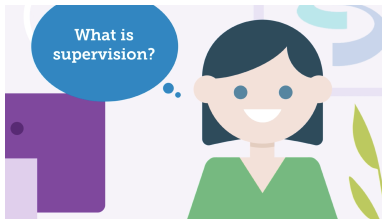Step into Leadership
Supervision
Supervision involves a manager and worker meeting regularly to talk about different aspects of their work. The purpose is to discuss workload, support workers wellbeing and to promote staff development. Supervision should provide accountability for both the manager and worker and have a particular focus on achieving better outcomes for people who use services and their carers.
In these short animations you will hear an overview of what supervision is and how important it is to feature wellbeing in supervision conversations.
In each of these videos we see colleagues from different areas of social services sharing how they do supervision and what’s important for them and their teams.
SSSC Supervision Learning Resource
This Supervision learning resource promotes good practice in supervision across social work and social services in Scotland. It draws on examples of good practice and includes resources and templates to support the development of supervision.
What is Supervision?
This document describes an approach to supervision and the benefits it offers. It discusses why supervision is important in social services and highlights responsibilities within the SSSC Codes of Practice for Social Service Workers and Employers and National Occupational Standards .
View pdfTypes of Supervision
Supervision presentation
This resource is a presentation which offers a framework to help you facilitate a discussion around effective supervision. An introduction to the presentation provides more information about the different ways in which the resource can support your practice.
View presentationSupervision Web Resources
What Others Say
Examples from Practice
Supervision quick links
SSSC Supervision Learning Resource What is Supervision? Types of supervision Supervision presentation Supervision Web Resources What Others Say Examples from Practice"Regular, high quality, organised supervision is critical, as are routine opportunities for peer learning and discussion."
Morrison, T & Wonnacott, J (2010) Supervision: Now or Never. http://www.in-trac.co.uk/supervision-now-or-never/
"Supervision for staff involved in complex work can help them to reflect on their practice and to practice effectively in face of resource and time limitations."
Johnstone, J & Miller, M. (2010) Staff Support and Supervision For Outcomes Based Working. Jit Scotland.










